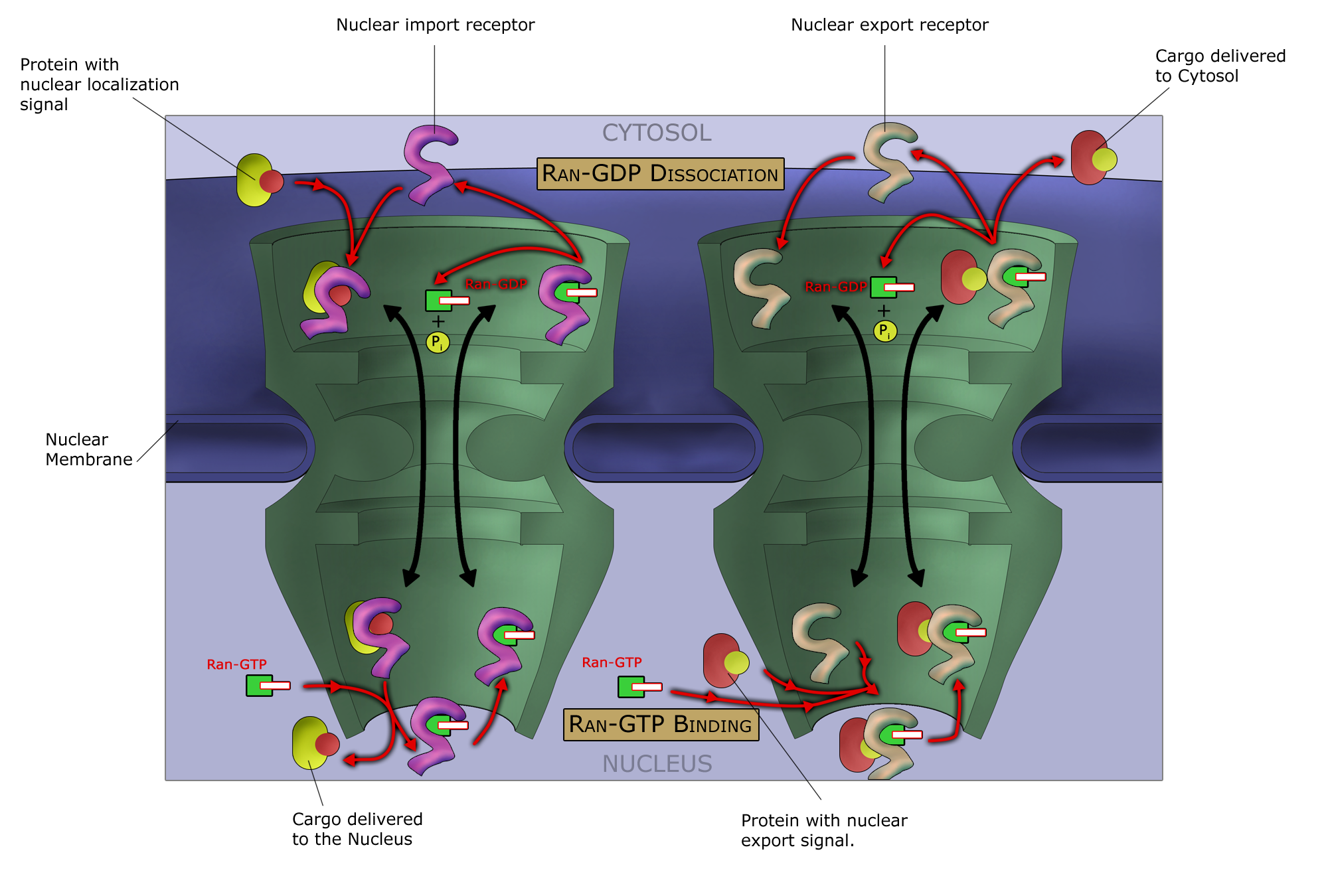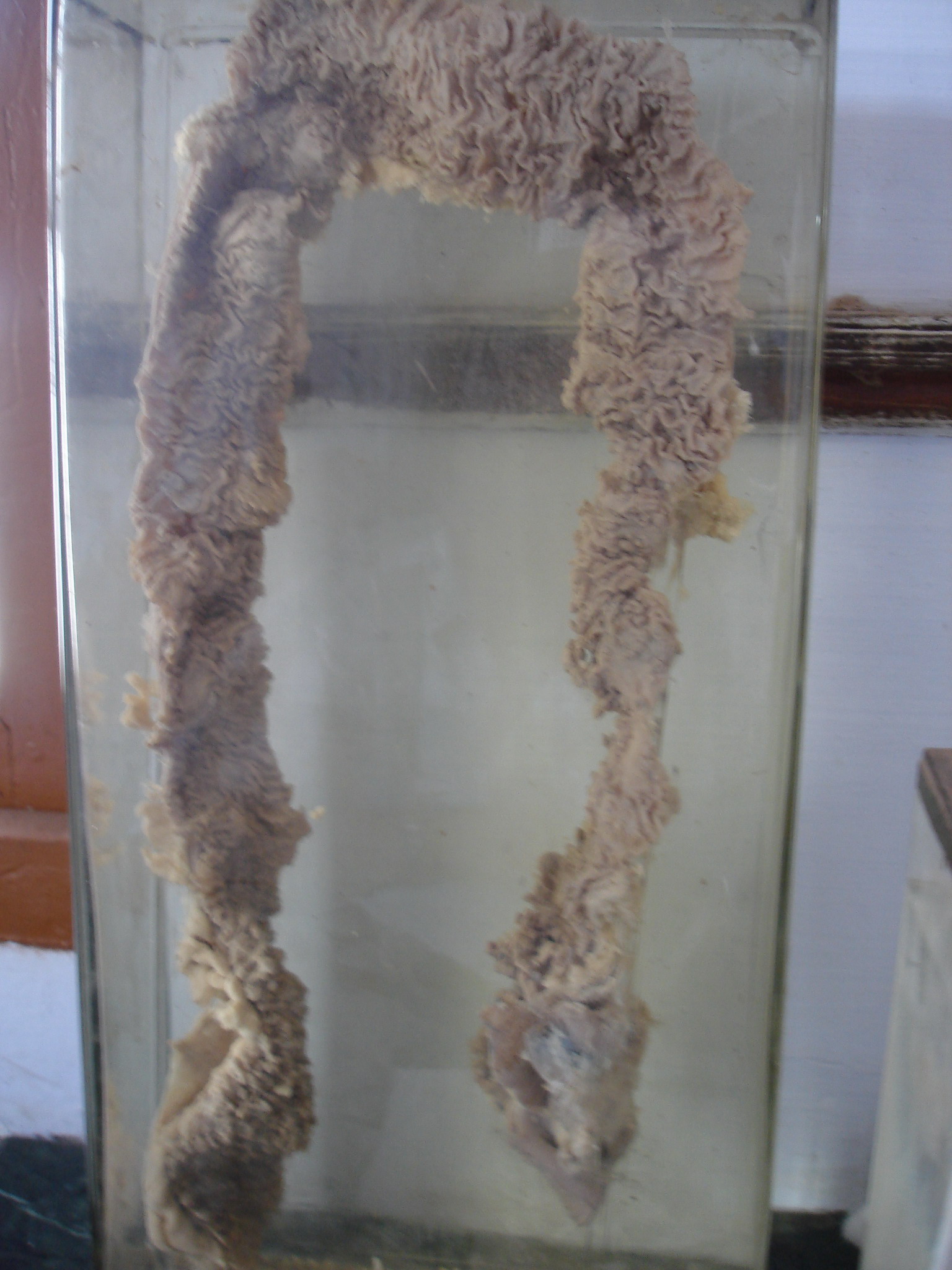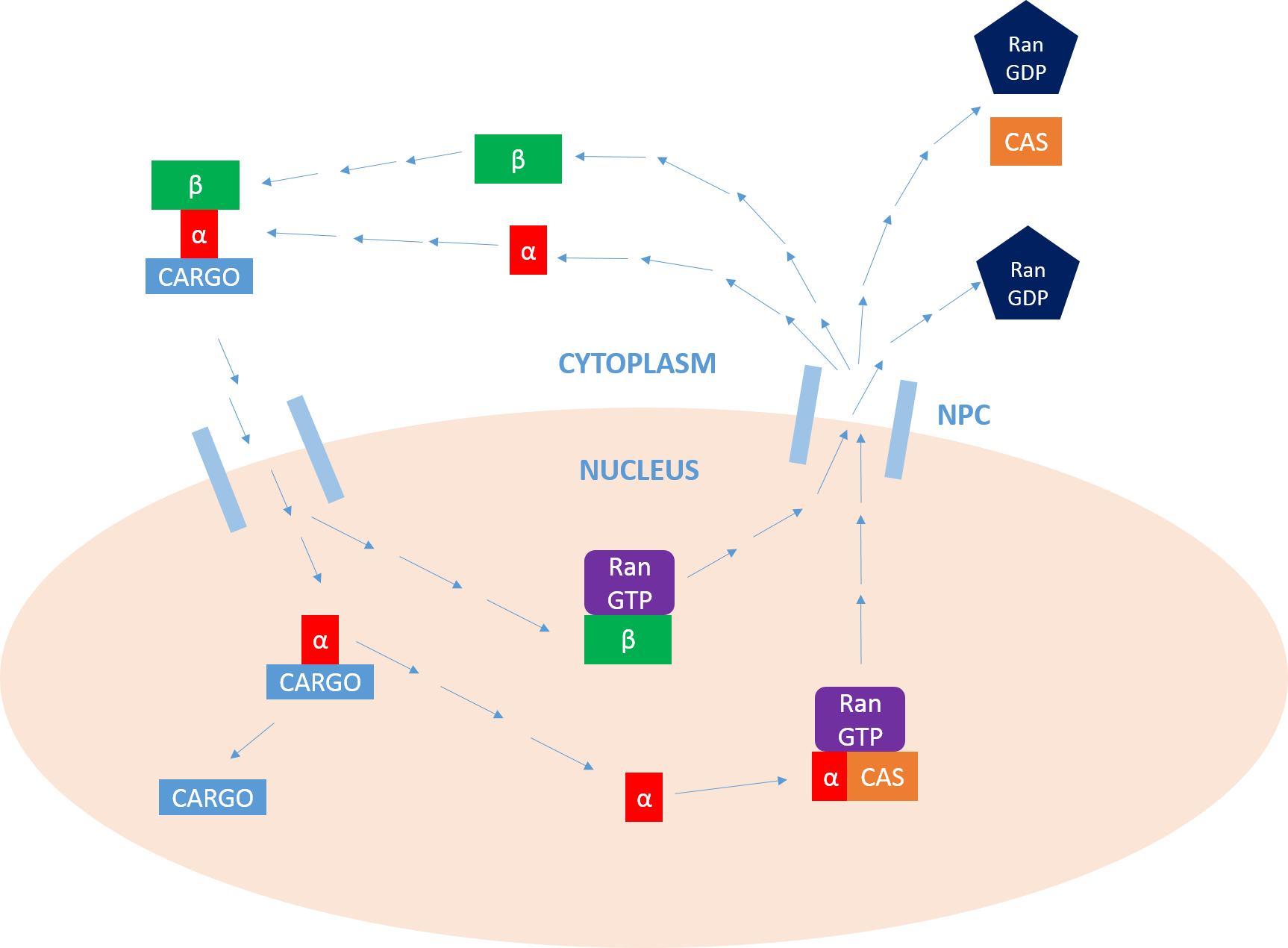|
XPO1
Exportin 1 (XPO1), also known as chromosomal region maintenance 1 (CRM1), is a eukaryotic protein that mediates the nuclear export of various proteins and RNAs. History XPO1 (CRM1) originally was identified in the fission yeast ''Schizosaccharomyces pombe'' in a genetic screen, and investigators determined that it was involved in control of the chromosome structure. It was later shown to be the nuclear transport receptor for cargos with leucine-rich nuclear export signals (NES). The structural details of the interaction of XPO1 with its cargos were revealed two decades after the gene was identified. Function XPO1 mediates NES-dependent protein transport. It exports several hundreds of different proteins from the nucleus. XPO1 is involved in the nuclear export of ribosomal subunits. XPO1 plays a role in export of various RNAs including U snRNAs, rRNAs (as a part of ribosomal subunits), and some mRNAs. Medical relevance XPO1 is involved in various viral infections. For exampl ... [...More Info...] [...Related Items...] OR: [Wikipedia] [Google] [Baidu] |
Selinexor
Selinexor sold under the brand name Xpovio among others, is a selective inhibitor of nuclear export used as an anti-cancer medication. It works by blocking the action of exportin 1 and thus blocking the transport of several proteins involved in cancer-cell growth from the cell nucleus to the cytoplasm, which ultimately arrests the cell cycle and leads to apoptosis. It is the first drug with this mechanism of action. The most common side effects include nausea (feeling sick), vomiting, decreased appetite, weight loss, diarrhea, tiredness, thrombocytopenia (low blood-platelet counts), anaemia (low red-blood cell counts), low levels of white blood cells and hyponatraemia (low blood sodium levels). Selinexor was granted accelerated approval by the U.S. Food and Drug Administration (FDA) in July 2019, for use in combination with the corticosteroid dexamethasone for the treatment of adults with relapsed refractory multiple myeloma (RRMM) who have received at least four prior therapie ... [...More Info...] [...Related Items...] OR: [Wikipedia] [Google] [Baidu] |
CIITA
CIITA is a human gene which encodes a protein called the class II, major histocompatibility complex, transactivator. Mutations in this gene are responsible for the bare lymphocyte syndrome in which the immune system is severely compromised and cannot effectively fight infection. Chromosomal rearrangement of CIITA is involved in the pathogenesis of Hodgkin lymphoma and primary mediastinal B cell lymphoma. Function CIITA mRNA can only be detected in human leukocyte antigen (HLA) system class II-positive cell lines and tissues. This highly restricted tissue distribution suggests that expression of HLA class II genes is to a large extent under the control of CIITA. However CIITA does not appear to directly bind to DNA. Instead CIITA functions through activation of the transcription factor RFX5. Hence CIITA is classified as a transcriptional coactivator. The CIITA protein contains an acidic transcriptional activation domain, 4 LRRs (leucine-rich repeats) and a GTP binding domain. ... [...More Info...] [...Related Items...] OR: [Wikipedia] [Google] [Baidu] |
Nucleoporin 62
Nuclear pore glycoprotein p62 is a protein complex associated with the nuclear envelope. The p62 protein remains associated with the nuclear pore complex-lamina fraction. p62 is synthesized as a soluble cytoplasmic precursor of 61 kDa followed by modification that involve addition of N-acetylglucosamine residues, followed by association with other complex proteins. In humans it is encoded by the ''NUP62'' gene. The nuclear pore complex is a massive structure that extends across the nuclear envelope, forming a gateway that regulates the flow of macromolecules between the nucleus and the cytoplasm. Nucleoporins are the main components of the nuclear pore complex in eukaryotic cells. The protein encoded by this gene is a member of the FG repeat containing nucleoporins and is localized to the nuclear pore central plug. This protein associates with the importin alpha/beta complex which is involved in the import of proteins containing nuclear localization signals. Multiple transcript va ... [...More Info...] [...Related Items...] OR: [Wikipedia] [Google] [Baidu] |
SMARCB1
SWI/SNF-related matrix-associated actin-dependent regulator of chromatin subfamily B member 1 is a protein that in humans is encoded by the ''SMARCB1'' gene. Function The protein encoded by this gene is part of a complex that relieves repressive chromatin structures, allowing the transcriptional machinery to access its targets more effectively. The encoded nuclear protein may also bind to and enhance the DNA joining activity of HIV-1 integrase. This gene has been found to be a tumor suppressor and mutations in it have been associated with malignant rhabdoid tumors. Two transcript variants encoding different isoforms have been found for this gene. Interactions SMARCB1 has been shown to interact with: * ARID1A, * BAZ1B, * BRCA1, * CREB-binding protein, * Cyclin-dependent kinase 8, * Myc, * P53, * POLR2A, * PPP1CA, * PPP1CB, * PPP1CC, * PPP1R15A, * SMARCA2, * SMARCA4, * SMARCC1, * SMARCE1, * SS18, and * XPO1 Exportin 1 (XPO1), also known as chromosomal region ... [...More Info...] [...Related Items...] OR: [Wikipedia] [Google] [Baidu] |
Ran (biology)
Ran (RAs-related Nuclear protein) also known as GTP-binding nuclear protein Ran is a protein that in humans is encoded by the RAN gene. Ran is a small 25 kDa protein that is involved in transport into and out of the cell nucleus during interphase and also involved in mitosis. It is a member of the Ras superfamily. Ran is a small G protein that is essential for the translocation of RNA and proteins through the nuclear pore complex. The Ran protein has also been implicated in the control of DNA synthesis and cell cycle progression, as mutations in Ran have been found to disrupt DNA synthesis. Function Ran cycle Ran exists in the cell in two nucleotide-bound forms: GDP-bound and GTP-bound. RanGDP is converted into RanGTP through the action of RCC1, the nucleotide exchange factor for Ran. RCC1 is also known as RanGEF (Ran Guanine nucleotide Exchange Factor). Ran's intrinsic GTPase-activity is activated through interaction with Ran GTPase activating protein (RanGAP), facilit ... [...More Info...] [...Related Items...] OR: [Wikipedia] [Google] [Baidu] |
RANBP3
Ran-binding protein 3 is a protein that in humans is encoded by the ''RANBP3'' gene. This gene encodes a protein with a RanBD1 domain that is found in both the nucleus and cytoplasm. This protein plays a role in nuclear export as part of a heteromeric complex. Alternate transcriptional splice variants, encoding different isoforms, have been characterized. Interactions RANBP3 has been shown to interact with RCC1 and XPO1 Exportin 1 (XPO1), also known as chromosomal region maintenance 1 (CRM1), is a eukaryotic protein that mediates the nuclear export of various proteins and RNAs. History XPO1 (CRM1) originally was identified in the fission yeast ''Schizosaccharom .... References Further reading * * * * * * * * * * * * * {{Gene-19-stub ... [...More Info...] [...Related Items...] OR: [Wikipedia] [Google] [Baidu] |
APC (gene)
Adenomatous polyposis coli (APC) also known as deleted in polyposis 2.5 (DP2.5) is a protein that in humans is encoded by the ''APC'' gene. The APC protein is a negative regulator that controls beta-catenin concentrations and interacts with E-cadherin, which are involved in cell adhesion. Mutations in the ''APC'' gene may result in colorectal cancer. ''APC'' is classified as a tumor suppressor gene. Tumor suppressor genes prevent the uncontrolled growth of cells that may result in cancerous tumors. The protein made by the ''APC'' gene plays a critical role in several cellular processes that determine whether a cell may develop into a tumor. The APC protein helps control how often a cell divides, how it attaches to other cells within a tissue, how the cell polarizes and the morphogenesis of the 3D structures, or whether a cell moves within or away from tissue. This protein also helps ensure that the chromosome number in cells produced through cell division is correct. The APC p ... [...More Info...] [...Related Items...] OR: [Wikipedia] [Google] [Baidu] |
CDKN1B
Cyclin-dependent kinase inhibitor 1B (p27Kip1) is an enzyme inhibitor that in humans is encoded by the CDKN1B gene. It encodes a protein which belongs to the ''Cip/Kip'' family of cyclin dependent kinase (Cdk) inhibitor proteins. The encoded protein binds to and prevents the activation of cyclin E-CDK2 or cyclin D- CDK4 complexes, and thus controls the cell cycle progression at G1. It is often referred to as a cell cycle inhibitor protein because its major function is to stop or slow down the cell division cycle. Function The p27Kip1 gene has a DNA sequence similar to other members of the "Cip/Kip" family which include the p21Cip1/Waf1 and p57Kip2 genes. In addition to this structural similarity the "Cip/Kip" proteins share the functional characteristic of being able to bind several different classes of Cyclin and Cdk molecules. For example, p27Kip1 binds to cyclin D either alone, or when complexed to its catalytic subunit CDK4. In doing so p27Kip1 inhibits the catalytic ... [...More Info...] [...Related Items...] OR: [Wikipedia] [Google] [Baidu] |
RANBP1
Ran-specific binding protein 1 is an enzyme that in humans is encoded by the ''RANBP1'' gene. Ran/TC4-binding protein, RanBP1, interacts specifically with GTP-charged RAN. RANBP1 encodes a 23-kD protein that binds to RAN complexed with GTP but not GDP. RANBP1 does not activate GTPase activity of RAN but does markedly increase GTP hydrolysis by the RanGTPase-activating protein (RANGAP1). The RANBP1 cDNA encodes a 201-amino acid protein that is 92% similar to its mouse homolog. In both mammalian cells and in yeast, RANBP1 acts as a negative regulator of RCC1 by inhibiting RCC1-stimulated guanine nucleotide release from RAN. Interactions RANBP1 has been shown to interact with XPO1, KPNB1 and Ran Ran, RaN and ran may refer to: Arts and entertainment * ''Ran'' (film), a 1985 film directed by Akira Kurosawa * "Ran" (song), a 2013 Japanese song by Luna Sea * '' Ran Online'', a 2004 MMORPG (massively multiplayer online role playing game) * .... References Further reading * * ... [...More Info...] [...Related Items...] OR: [Wikipedia] [Google] [Baidu] |
NMD3
60S ribosomal export protein NMD3 is a protein that in humans is encoded by the ''NMD3'' gene. Interactions NMD3 has been shown to interact with XPO1 Exportin 1 (XPO1), also known as chromosomal region maintenance 1 (CRM1), is a eukaryotic protein that mediates the nuclear export of various proteins and RNAs. History XPO1 (CRM1) originally was identified in the fission yeast ''Schizosaccharom .... References Further reading * * * * {{protein-stub ... [...More Info...] [...Related Items...] OR: [Wikipedia] [Google] [Baidu] |
Importin
Importin is a type of karyopherin that transports protein molecules from the cell's cytoplasm to the nucleus. It does so by binding to specific recognition sequences, called nuclear localization sequences (NLS). Importin has two subunits, importin α and importin β. Members of the importin-β family can bind and transport cargo by themselves, or can form heterodimers with importin-α. As part of a heterodimer, importin-β mediates interactions with the pore complex, while importin-α acts as an adaptor protein to bind the nuclear localization signal (NLS) on the cargo. The NLS-Importin α-Importin β trimer dissociates after binding to Ran GTP inside the nucleus, with the two importin proteins being recycled to the cytoplasm for further use. Discovery Importin can exist as either a heterodimer of importin-α/β or as a monomer of Importin-β. Importin-α was first isolated in 1994 by a group includinEnno Hartmann based at the Max Delbrück Center for Molecular Medicine. The p ... [...More Info...] [...Related Items...] OR: [Wikipedia] [Google] [Baidu] |
Karyopherin
Karyopherins are proteins involved in transporting molecules between the cytoplasm and the nucleus of a eukaryotic cell. The inside of the nucleus is called the karyoplasm (or nucleoplasm). Generally, karyopherin-mediated transport occurs through nuclear pores which acts as a gateway into and out of the nucleus. Most proteins require karyopherins to traverse the nuclear pore. Karyopherins can act as ''importins'' (i.e. helping proteins get into the nucleus) or ''exportins'' (i.e. helping proteins get out of the nucleus). They belong to the nuclear pore complex family in the transporter classification database (TCDB). Energy for transport is derived from the Ran gradient. Upon stress, several karyopherins stop shuttling between the nucleus and the cytoplasm and are sequestered in stress granules, cytoplasmic aggregates of ribonucleoprotein complexes. Importin beta Importin beta is a variety of karyopherin that facilitates the transport of cargo proteins into the nucleus. First, ... [...More Info...] [...Related Items...] OR: [Wikipedia] [Google] [Baidu] |


